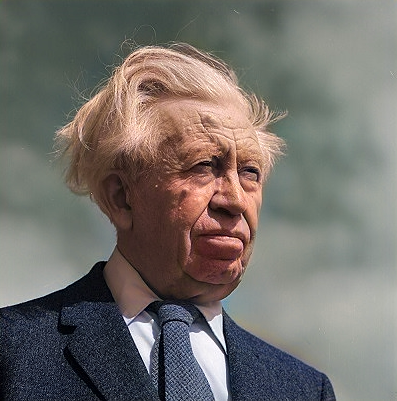Vilhjalmur Stefansson was a famous arctic explorer whose expeditions are beyond legendary.
He lived with the Inuit and learned to eat & thrive off of their native, Arctic foods. In 1928, Stefansson determined that he was ready for his next challenge.
No, this challenge would not be another overseas voyage, but rather a challenge that he could complete right in New York City.
“Can I eat nothing but meat for an entire year?” This was the question and challenge that Stefansson posed to himself.
Stefansson wanted to prove the effectiveness of the Inuit diet that he watched the indigenous population consume for years.
He watched them consume a primary meat and fish diet that consisted of: Seals, Whale, Caribou, Waterfowl, with very limited vegetable consumption.

By conventional measures, the Inuit had no business being healthy. They spent months in the darkness of Winter, unable to hunt or do real work.
However, Stefansson observed that they were the healthiest people he had ever seen.
He saw virtually no obesity or disease.
Stefansson believed that the high saturated fat content of the Inuit diet (70-80% of total Inuit calories came from Fat) was the mechanism allowing these people to thrive.
Stefansson observed that Fat was the most precious dietary input to every Inuit he observed.
Upon hunting a Caribou, the Inuit people would savor the Fat deposits behind the eye and jaw, in addition to the organs and shoulder.
The leaner parts were fed to the dogs.
This contrasted the nutritional narrative that individuals like John Harvey Kellogg were pushing at the time.
Religious fanatics like Kellogg believed that raw vegetables and grains were "virtuous" and Meat / Saturated Fats were sinful.
Western Doctors also believed the Inuit diet to be vitamin-deficient and dangerous.
Stefansson saw a different perspective, as the Inuit population he observed was utterly thriving. He also realized that the oils, livers, and fish offered essential nutrients.
In addition, Stefansson himself ate a native Innuit diet for years starting in 1906, when his food supplies failed to show up during his voyage that year.
He couldn't believe how good he felt on their Arctic diet that consisted of fish, meat, and saturated fat.
To properly monitor his carnivore experiment, Stefansson checked himself into New York's bellevue Hospital with a fellow explorer.
They spent multiple weeks receiving blood tests and had various biomarkers checked.
After the control period ended, their staple foods they consumed were very simple. They ate:
Steak
Roast Beef
Brains
Tongue
Calf Liver - Once per week to prevent Scurvy
And were committed to doing this for an entire calendar year…

Newspapers, periodicals, and various doctors condemned Stefansson's experiment as dangerous. They insisted that the men would get scurvy or even potentially die.
Stefansson defied all critics and insisted that his all meat diet filled him with ambition and energy.
Upon examining the two men during their year-long experiment, the doctors reported that neither man showed elevated blood pressure or kidney troubles that were expected of a carnivore diet.
Stefansson became ill only once during the year - and this is when experimenters had him cut out the fat from his meat and eat leaner cuts.
This illness was quickly corrected by a meal of sirloin steak and brains cooked in bacon fat. His symptoms immediately improved.
The men also ensured that they did not contract scurvy because they were intentional about eating the entire animal including the bones, organs, and brain.
At the end of the year, both men reported that they felt fantastic and were in amazing health.
The Experimenters reported on their health:

Stefansson concluded that the protein of the all-meat diet was not as important as the Fat.
In 1955, Stefansson adopted a "stone-age" diet that was high-fat, low carb and primarily meat. He was also notorious for eating globs of butter on a spoon!
As we reflect, we can confidently say that Stefansson was a man beyond his time and was able to tap into the incredible benefits of Saturated Fat.
Ketogenic, Carnivore, and Animal-based eating approaches leverage Saturated Fat over carbohydrates.
Many people that follow a high fat & low carb diet have noticed rapid weight loss, improved blood sugar, decreased blood pressure and anxiety and depression.
Physicians such as Dr. Brian Lenzkes have gotten dozens of diabetic patients off insulin by leveraging a high-fat / low carb approach to eating.
There are some other amazing benefits to a high fat diet that include:
- Stronger Bones
- Improved Cardiovascular health
- Liver Health
- Lung Function
- Brain Health
Our founder, Phillip, leveraged a carnivore diet to cure himself of gut issues and illnesses that he was battling while being deployed overseas in the US Army.
His results have been transformative.
We write this blog to encourage you to experiment with your own diet and take autonomy of the food you put into your body.
Western medicine has left 70% of the US population overweight or obese through backwards dietary guidelines.
We put vegetable oils, refined sugars & carbohydrates on a pedestal yet demonize Saturated Fat & Cholesterol which is essential for human function.
Our bar, which is a modern take on pemmican, is a push back to modern dietary guidelines. We specifically created a bar that contains the most nutrient-dense foods such as: regenerative beef, tallow, and salt.

We specifically include 35g of saturated fat in each bar to keep you energized and satiated. We want you to have the energy to do badass things with your life!
Stories like Stefansson's and our own at the Carnivore Bar are a testament to the incredible benefits of saturated fat and the healing powers of a carnivore diet.
Also in case you are wondering, Vilhjalmur lived until the ripe old age of 82 years old.


Leave a comment: